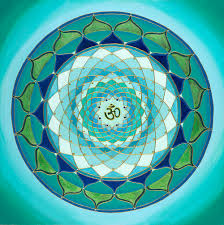OM :: in Sanatana Dharma (Hinduism)

The syllable "om" is first described as all-encompassing mystical entity in the Upanishads. Today, in all Hindu art and all over India and Nepal, 'om' can be seen virtually everywhere, a common sign for Hinduism and its philosophy and theology. Hindus believe that as creation began, the divine, all-encompassing consciousness took the form of the first and original vibration manifesting as sound "OM". Before creation began it was "Shunyākāsha", the emptiness or the void. Shunyākāsha, meaning literally "no sky", is more than nothingness, because everything then existed in a latent state of potentiality. The vibration of "OM" symbolizes the manifestation of God in form ("sāguna brahman"). "OM" is the reflection of the absolute reality, it is said to be "Adi Anadi", without beginning or the end and embracing all that exists. The mantra "OM" is the name of God, the vibration of the Supreme. When taken letter by letter, A-U-M represents the divine energy (Shakti) united in its three elementary aspects: Bhrahma Shakti (creation), Vishnu Shakti (preservation) and Shiva Shakti (liberation, and/or destruction).


 OM :: AUM
OM :: AUM
OM :: AUM
OM :: Name, phonology and written representation
The Sanskrit name for the syllable is praṇava, from a root nu "to shout, sound", verbal pra-nu- being attested as "to make a humming or droning sound" in the Brahmanas, and taking the specific meaning of "to utter the syllable om" in the Chāndogya Upanishad and the Shrauta Sutras. More rarely used terms are akṣara (lit. symbol, character) or ekākṣara (lit. one symbol, character), and in later times omkāra becomes prevalent.
Phonemically, the syllable is /aum/, which is regularly monophthongized to [õː] in Sanskrit phonology. It is sometimes also written with pluti, as o3m (ओ३म्), notably by Arya Samaj. When occurring within a Sanskrit utterance, the syllable is subject to the normal rules of sandhi in Sanskrit grammar, however with the additional peculiarity that after preceding a or ā, the au of aum does not form vriddhi (au) but guna (o) per Pāṇini 6.1.95 (i.e. 'om').
The om symbol is a ligature of Devanagari ओ+ँ (oṃ, encoded in Unicode at U+0950 ॐ, the Tibetan script variant ༀ at U+0F00, and the Chinese version 唵 at U+5535 or 吽 at U+543D).
OM :: AUM
Om or aum (written universally as ॐ; in Devanagari as ओं oṃ [õː], औं auṃ [ə̃ũ], or ओम् om [õːm]) is a mystical Sanskrit sound of Hindu origin, sacred and important in various Dharmic religions such as Hinduism, Buddhism and Jainism. The syllable is also referred to as omkara (ओंकार oṃkāra) or aumkara (औंकार auṃkāra), literally "om syllable", and in Sanskrit it is sometimes referred to as प्रणव (praṇava), literally "that which is sounded out loudly".

Om is also written ओ३म् (ō̄m [õːːm]), where ३ is प्लुत (pluta, "three times as long"), indicating a length of three morae (that is, the time it takes to say three syllables)—an overlong nasalized close-mid back rounded vowel—though there are other enunciations adhered to in received traditions. It is placed at the beginning of most Hindu texts as a sacred incantation to be intoned at the beginning and end of a reading of the Vedas or prior to any prayer or mantra. It is used at the end of the invocation to the god being sacrificed to (anuvakya) as an invitation to and for that God to partake of the sacrifice.. The Māndukya Upanishad is entirely devoted to the explanation of the syllable. The syllable consists of three phonemes, a (Vaishvanara), u (Hiranyagarbha), and m (Ishvara), which symbolize the beginning, duration, and dissolution of the universe and the associated gods Brahma, Vishnu, and Shiva, respectively. The name omkara is taken as a name of God in the Hindu revivalist Arya Samaj and can be translated as "I Am Existence".

